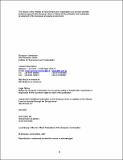Por favor, use este identificador para citar o enlazar a este item:
http://hdl.handle.net/10261/157427COMPARTIR / EXPORTAR:
 SHARE
BASE SHARE
BASE
|
|
| Visualizar otros formatos: MARC | Dublin Core | RDF | ORE | MODS | METS | DIDL | DATACITE | |

| Título: | Improving the performance of the BAIM index for burnt area mapping using MODIS data |
Autor: | Gómez Nieto, Israel CSIC ORCID; Martín, M. Pilar | Palabras clave: | BAIM Burnt area mapping MODIS |
Fecha de publicación: | 2007 | Editor: | European Commission | Citación: | 6th International Workshop of the EARsel Special Interest Group on Forest Fires. Thessaloniki (Greece). 27-29 September 2007, págs.: 172-176 | Resumen: | The analysis of fire effects and its influence on the structure, composition and functioning of
terrestrial ecosystems (Michalek et al., 2000) at regional and global scales relies on the feasibility of obtaining
accurate estimations on burnt areas. Remote sensing has proven to be an adequate tool for this objective and
many different methodologies have been proposed in order to obtain maps of burnt area on different scales. Most
methodologies are based on the use of spectral indices, some of which have been traditionally applied to estimate
vegetation conditions, such as the NDVI, whereas others have been specifically designed for burnt area mapping
(Kasischke and French, 1996; Barbosa et al., 1996; Martín and Chuvieco, 1998; Trigg and Flasse, 2001;
Chuvieco et al., 2005). Among the latter is the Burnt Area Index (BAI) which was originally designed for burnt
area mapping using NOAA-AVHRR data (Martín, 1998). BAI was recently adapted to MODIS data (BAIM)
increasing its discrimination ability by including information from the MODIS SWIR bands (Martín et al., 2005).
In spite of the good performance showed by the BAIM in discriminating recently burned areas in different
environments (Martin et al., 2005; http://www.geogra.uah.es/aql/), some confusions have been reported regarding
specific land covers. This paper proposes an improvement of BAIM by implementing two new factors in order to
increase the discrimination capability and to reduce reported confusions between burnt and unburnt covers
(especially those containing water bodies). The design of the Improved BAIM index (IBAIM) is based on the statistical analysis of sample pixels obtained from MODIS images. The samples where selected using images from two different years (2001 and 2003) and include the most representative landcovers in the Iberian Peninsula as well as burned areas. The accuracy of the new index was tested using official fire perimeters obtained with GPS and also by visual interpretation of high resolution images. |
Versión del editor: | https://ec.europa.eu/jrc/en/publication/eur-scientific-and-technical-research-reports/proceedings-6th-international-workshop-earsel-special-interest-group-forest-fires-advances | URI: | http://hdl.handle.net/10261/157427 | ISBN: | 978-92-79-06620-7 |
| Aparece en las colecciones: | (CCHS-IEGD) Comunicaciones congresos |
Ficheros en este ítem:
| Fichero | Descripción | Tamaño | Formato | |
|---|---|---|---|---|
| 6th_EARsel_Workshop.pdf | 238,22 kB | Adobe PDF |  Visualizar/Abrir |
CORE Recommender
Page view(s)
321
checked on 24-abr-2024
Download(s)
175
checked on 24-abr-2024
Google ScholarTM
Check
Altmetric
NOTA: Los ítems de Digital.CSIC están protegidos por copyright, con todos los derechos reservados, a menos que se indique lo contrario.
